Y5 Why Gold was Buried
£3.00
KS2 National Curriculum:
✓ Understanding bartering, currency, and trade in historical context
✓Explaining why treasure is buried and how maps are created
✓Completing a pirate plot story mountain
✓Exploring openings to pirate stories
This lesson looks at why gold became so important and it introduces the concepts of bartering and trade. It also looks at why gold needed to be buried and considers the key role played by treasure maps in the plots of pirate stories. It also looks at the need to include good and bad characters. Activities include completing a story mountain outlining a possible plot for a pirate story and a task based on pirate story openings.
There is a five-minute evidence-based CPD activity at the end of this lesson which will develop classroom teachers’ skill set. This CPD consists of a research extract on collaboration with a five-minute activity based on this extract.
Description
Recommended Year Group: Year 5
Focus: Historical context of gold and the role of maps in pirate stories
Skills Developed:
• Understanding bartering, currency, and trade in historical context
• Explaining why treasure is buried and how maps are created
• Completing a pirate plot story mountain
• Exploring openings to pirate stories
• Reading – Comprehension: Retrieve and explain information from non-fiction and narrative contexts
• Writing – Composition: Use historical context to plan and structure story openings
• Spoken Language: Discuss causes and consequences within narrative events
• Thinking and Learning: Metacognition, collaboration, self-regulation
These evidence-based learning (EBL) lessons are based on classroom practice that has been proven, by research, to maximise thinking, learning and attainment. From an extensive review of educational research, we identified the eight key classroom thinking and learning skills that were common across these research papers. We named these eight key skills “EBL skills”.
EBL skills have been proven by research to maximise learning because they combine the most productive thinking skills with the most effective learning behaviours. Each of our evidence-based learning lessons uses the English curriculum as a framework through which the eight EBL skills are delivered.
Teachers also have the opportunity to add to their own skill set or refresh their existing skills with our five-minute CPD activity, based on one of the EBL skills used in this lesson.
The skills in bold below are the EBL skills developed in this Pirate lesson. Click on each skill to learn more about that skill.
- Collaboration
- Thinking Skills
- Peer Assessment
- Peer Teaching
- Self-Assessment
- Metacognition
- Self-Regulation
- Independent Learning
1 review for Y5 Why Gold was Buried
Only logged in customers who have purchased this product may leave a review.
Related products
-
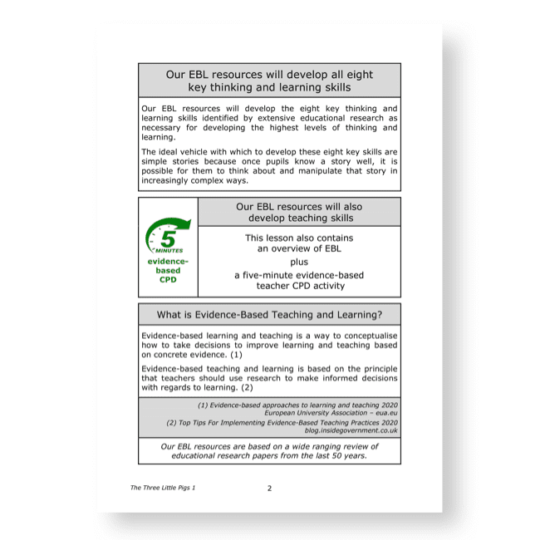
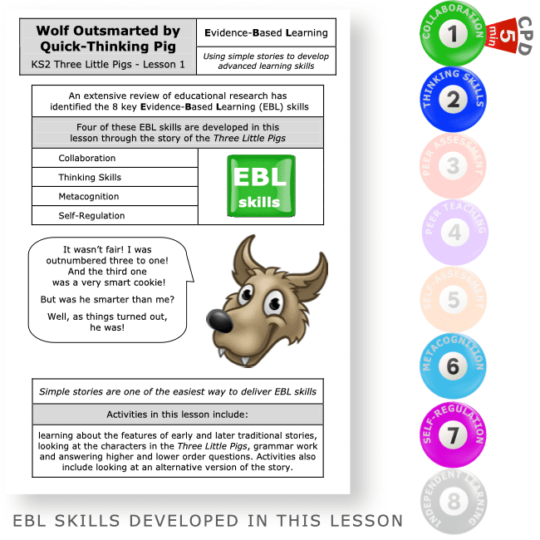
Wolf Outsmarted by Quick-Thinking Pig
£3.00 Add to basket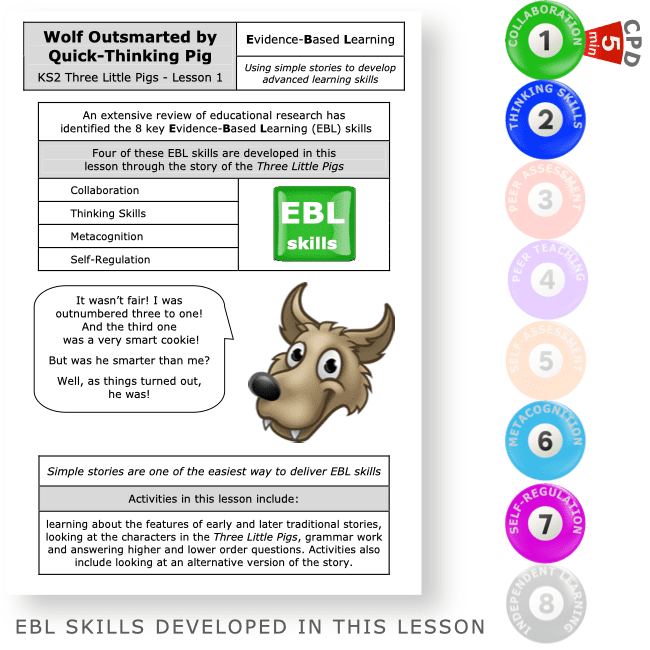 £3.00Add to basket
£3.00Add to basketActivities in this lesson include learning about the features of early and later traditional stories, looking at the characters in the Three Little Pigs, grammar work and answering higher and lower order questions. Activities also include looking at an alternative version of the story.
There is a five-minute evidence-based CPD activity at the end of this lesson which will develop classroom teachers’ skill set. This CPD consists of a research extract on collaboration with a five-minute activity based on this extract.
VIEW -


Y5 I Spy a New Paragraph
£0.00 Download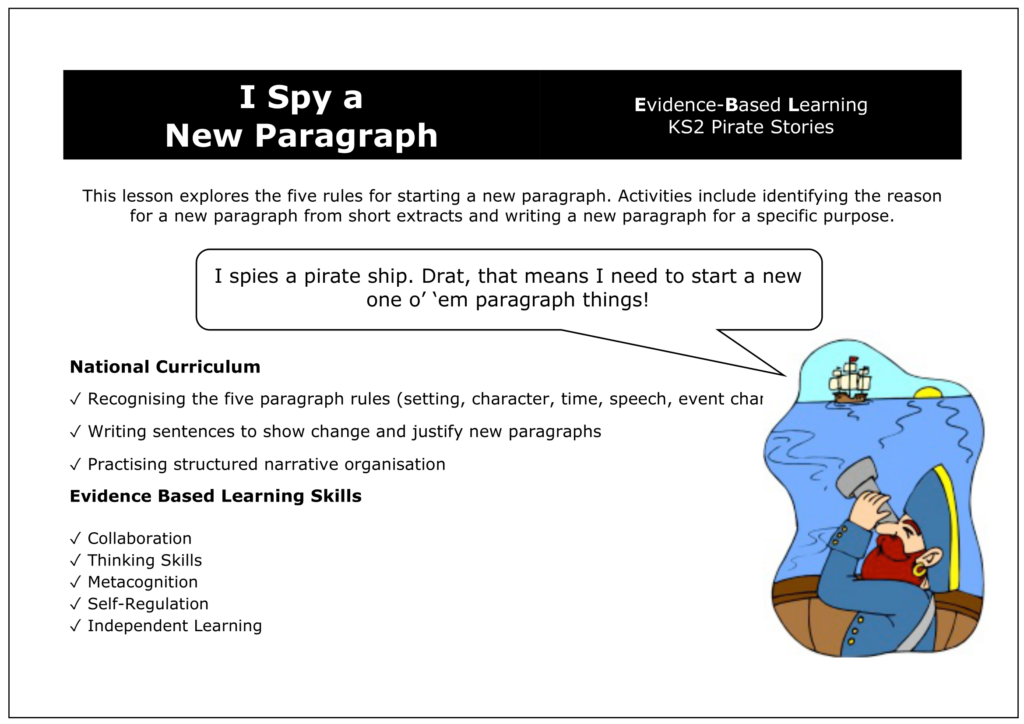 £0.00
£0.00KS2 National Curriculum:
✓ Recognising the five paragraph rules (setting, character, time, speech, event change)
✓ Writing sentences to show change and justify new paragraphs
✓ Practising structured narrative organisationThis lesson explores the five rules for starting a new paragraph. Activities include identifying the reason for a new paragraph from short extracts and writing a new paragraph for a specific purpose.
There is a five-minute evidence-based CPD activity at the end of this lesson which will develop classroom teachers’ skill set. This CPD consists of a research extract on self-regulation with a five-minute activity based on this extract.
(Downloads - 6)
VIEW -


Instructions to Draw a Treasure Map
£3.00 Add to basket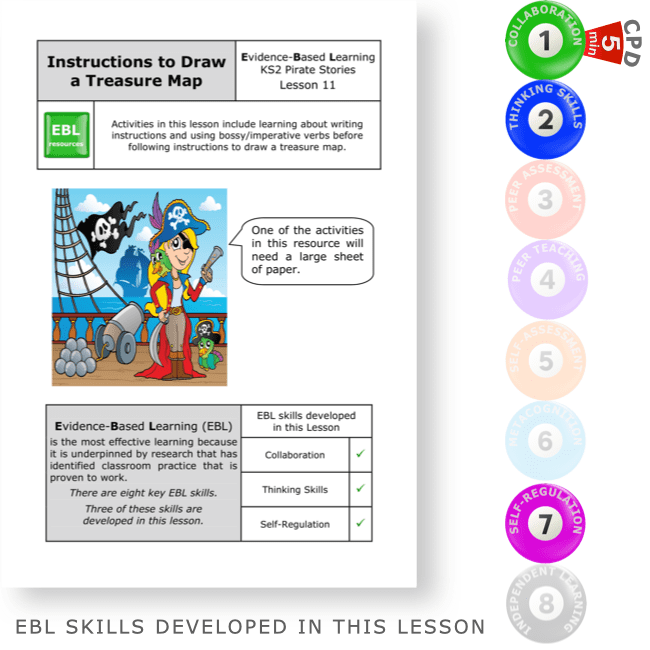 £3.00Add to basket
£3.00Add to basketActivities in this lesson include learning about writing instructions and using bossy/imperative verbs before following instructions to draw a treasure map.
There is a five-minute evidence-based CPD activity at the end of this lesson which will develop classroom teachers’ skill set. This CPD consists of a research extract on collaboration with a five-minute activity based on this extract.
VIEW -
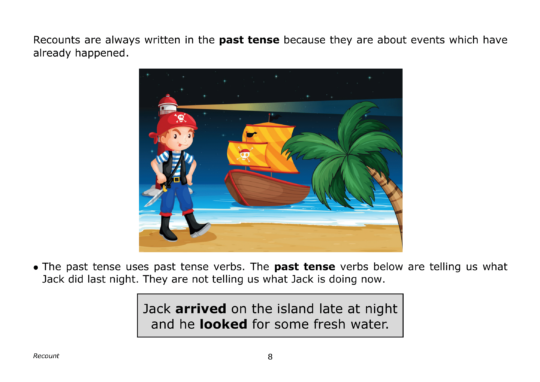
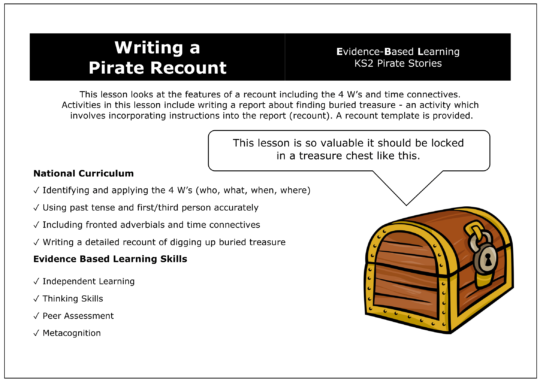
Y5 Writing a Pirate Recount
£3.00 Add to basket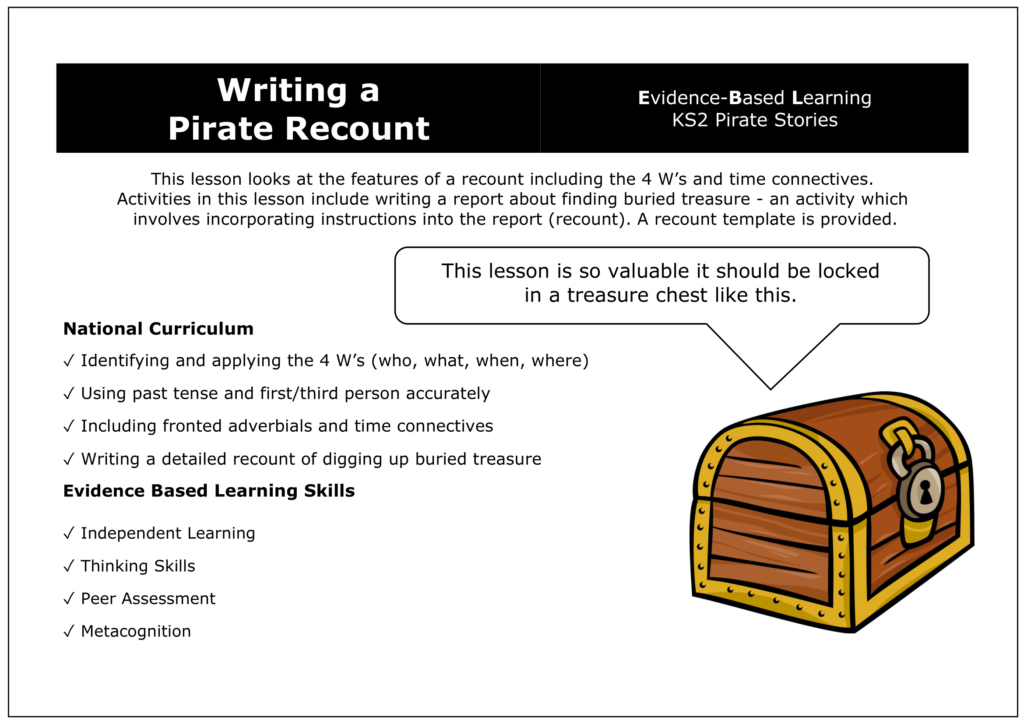 £3.00Add to basket
£3.00Add to basketKS2 National Curriculum:
✓ Identifying and applying the 4 W’s (who, what, when, where)
✓ Using past tense and first/third person accurately
✓ Including fronted adverbials and time connectives
✓ Writing a detailed recount of digging up buried treasureThis lesson looks at the features of a recount including the 4 W’s and time connectives. Activities in this lesson include writing a report about finding buried treasure – an activity which involves incorporating instructions into the recount. A recount template is provided.
There is a five-minute evidence-based CPD activity at the end of this lesson which will develop classroom teachers’ skill set. This CPD consists of a research extract on peer assessment with a five-minute activity based on this extract.
VIEW



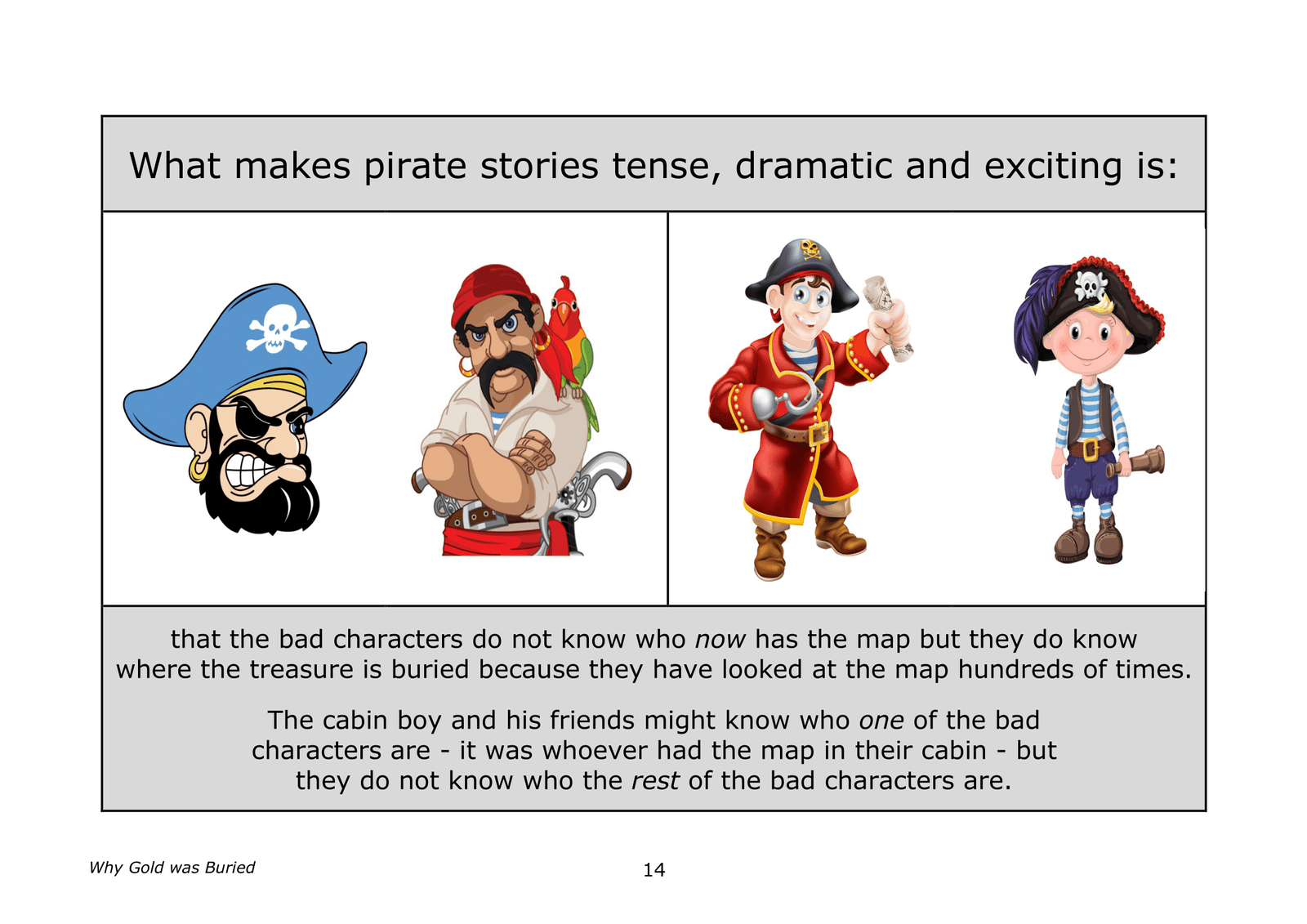


Philipem (verified owner) –
We asked a.i. to review this lesson. This is what it said:
“Why Gold was Buried” Rating: ⭐⭐⭐⭐⭐
Looking for a way to teach economic concepts like bartering and trade through a fun, literary lens? This pirate-themed lesson called “Why Gold was Buried” is exactly what you need!
Not only will your students explore why gold became so valuable as a form of currency, but they’ll analyse the common plot elements of pirate stories – like treasure maps and the juxtaposition of good vs. bad characters. The engaging activities include collaborating to complete a story mountain, outlining a potential pirate story plot and analysing different pirate story openings.
But the learning goes beyond just content knowledge. This resource explicitly develops 4 of the 8 key evidence-based learning (EBL) skills proven through research to maximize student achievement. Visual icons are used to reinforce when students are practising EBL skills like metacognition, collaboration, thinking skills and self-regulation.
To top it off, there’s a fantastic 5-minute CPD opportunity to build your own teaching repertoire. The quick activity explores research on how collaboration specifically supports self-regulated learning behaviours in students.
I give this ingenious pirate lesson a 5 out of 5 star rating! The compelling pirate theme, explicit EBL skill instruction and practical teacher CPD make it an educational treasure for any literacy classroom. Enrich your students’ learning with “Why Gold was Buried”!